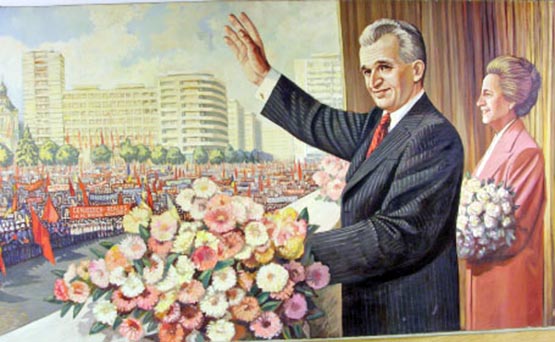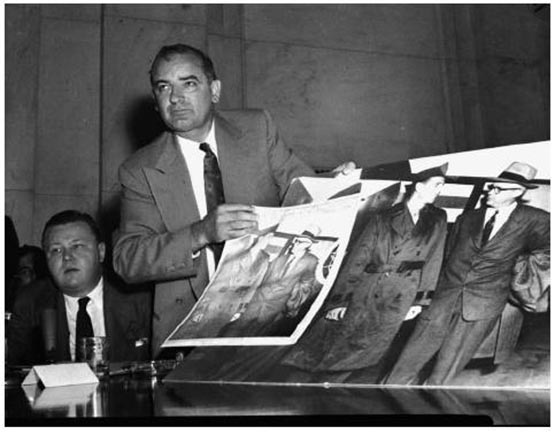
Exercise 1; Portraits of the Demagogue, Ceausceau
It is a feature of the Demagogue that the face of the ruler be displayed
at all times in an idealised format, with strong hints (then statements)
of supernatural powers, eg Stalin's official portraits and rallies,
the Nurenburg Rallies of the Nationalist Socialist Party in Germany,
the mountains carved into the portraits of Fernand and Imelda Marcos,
the personality cult of Kim Il Sung in Korea. The photographic and filmic
images are capable of reproducing the image of the ruler, but under
close supervision.
1.1 the unedited footage of the investigation and death of the Ceaucescus.
1.2 the final rally, the popular feeling is vented
1.3 the scoring and destruction of the photograph
1.4 the portrait of the ruler, visits to China and North Korea.
1.5 Ceaucescu in London, the need to be seen, planes for strawberries.
1.6 the faking of participation, at the rally.
1.7 rules of editing
1.8 the disappearing security chief
1.9 hunting and achievement, scratching on the flashes.
Exercise 2. the cropping of Stevens and Schine.

Photographs
can also change meaning above and beyond the manipulation of the surface.
The existing image can be cropped to alter the meaning. In the example
used below, one figure, Colonel Bradley, was removed in the evidence
presented to HUAC - a powerful and prestigious body which the influential
anti-Communist Senator McCarthy was using to pursue his own political
ambitions. When this was revealed the emphasis of the evidence shifted
subtly.
Senator Joseph Macarthy, the junior senator from Wisconsin,
Roy Cohn, leading anti-Communist lawyer, McCarthy's attorney at the
Army Hearings.
David Schine, anti-communist writer, friend of Cohn and Macarthy, called
up into the Army at this time. McCarthy was trying to get Schine light
duties to protect him.
The House Committee on Un-American Activities,(HUAC) prime investigator
of foreign and domestic Communist infiltration.
The Army Hearings, HUAC's investigation into Communist infiltration
into the American armed forces.
Joseph Welch, Boston lawyer and the attorney representing the Army at
the hearings.
Robert Stevens, Secretary of the Army under the Republican President
Eisenhower.
Robert Kennedy, counsel to the Committee, to be seen in the background.
The False Impression
(cropping the image for HUAC) On November 17th 1953
a photograph was taken of Secretary Stevens, David Schine, and Colonel
Kenneth Bradley, the McGuire Air Force base commander. Stevens had given
a lift to the influential Schine and the photograph was thus politically
most sensitive.
2.1
anon, Army Secretary Stevens and Private Schine.
2.2 Emilio Antonio, Point of Order , film, sequence devoted to the cross
examination of Senator Joe Macarthy and his attorney, Roy Cohn by the
Army counsel.
"In the spring of 1953 it looked like Joe [Macarthy], Roy [Cohn]
and their friends were on their way to taking over the world "
"Looking at the glossies of the cropped and uncropped pictures
two generations later, it scarcely seemed to matter, but during the
hearings the 'doctored' picture was the smoking gun of Joe McCarthy
and Roy Cohn's duplicity, the proof you couldn't trust them." Hoffman
p201.
"I should say Mr.Senator that a pixie is a close relative of a
fairy. Shall I proceed, sir/" Hoffman p.201.
BOOKLIST
Harold Evans, Pictures on a Page ,
John Faber, Great News Photos and the Stories behind them
, Dover NY 1978.
Baynes,etc Scoop Scandal and Strife, a study of photography
in newspapers, Lund Humphries, 1971
The Editors of Life, Photo Journalism ,Time-Life Books Amsterdam 1976
David Caute, The Great Fear, The Anti-Communist Purge under Truman and
Eisenhower,Touchstone,NY 1978
Nicholas Von Hoffman, Citizen Cohn ,Harrap London 1988.

NO.2 THE KENNEDY ASSASSINATION
|


